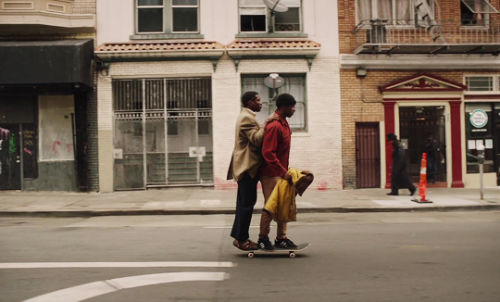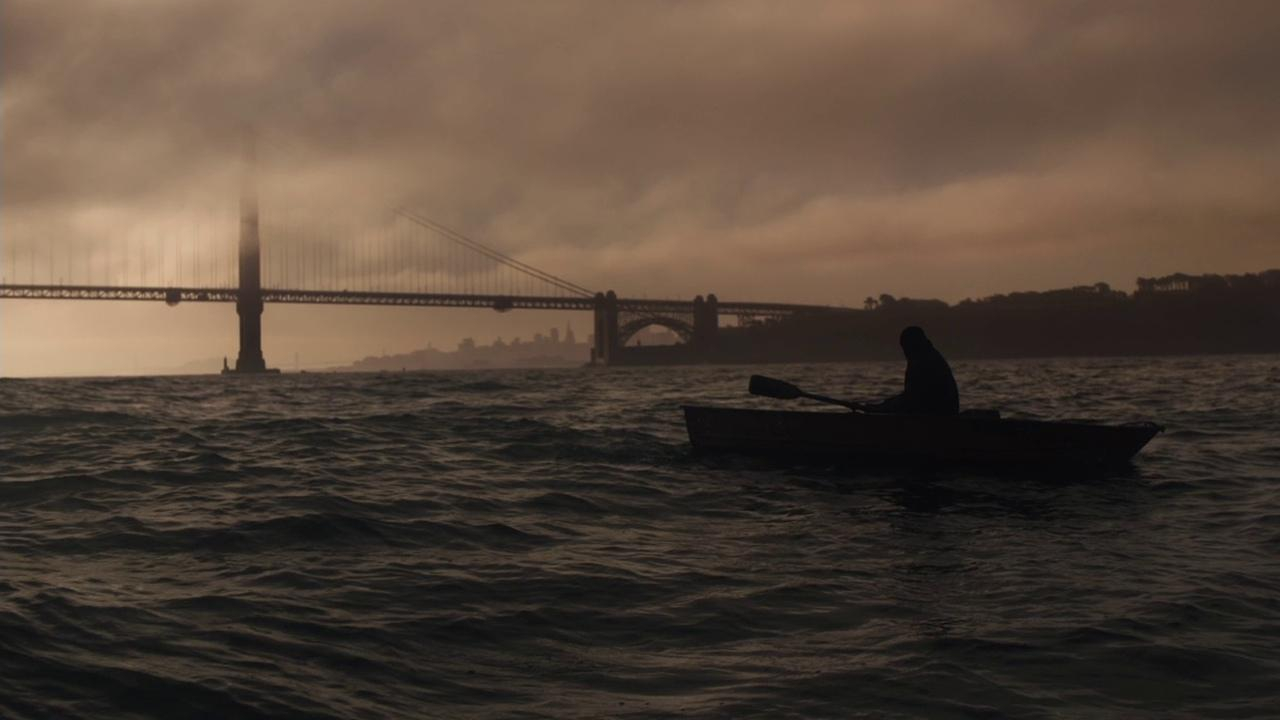|
 Released 2019 Directed by Joe Talbot Running time: 121 minutes  Please be aware I plan on spoiling the film as I talk about it here. If you would like to watch it first, you can find it on Max here and Netflix here. In 1979, Jello Biafra ran for mayor of San Francisco. Like most (all?) third-party electoral campaigns, he had no expectation of winning. His primary objective was to be a pain in the rear end for frontrunning Democrat Dianne Feinstein, who had promises to "clean up the city," which Jello interpreted to mostly mean rounding up and/or chasing off homeless people. Explaining his motives, he said "I have never been fond of her, and any grief I can cause that creature, I'm happy to oblige. But that wasn't why I ran for Mayor. It was more like: wouldn't this be a great prank?" Surprisingly, Biafra finished third with about 3.8% of the vote, the largest margin of any third-party candidate in San Francisco mayoral election history. Feinstein, of course, won the election; and went on to massively raise rents across the city, vetoed a vacancy control bill twice, and implemented the "hotline hotel" program, where SRO hotels that previously functioned as low-income housing were converted into temporary hotels for San Francisco's homeless with a three-night maximum stay. Feinstein was mayor from 1978 to 1988, and a Census Bureau poll estimated that the homeless population in San Francisco increased between the years of 1980 and 1990 anywhere between 29 and 72 percent. David Talbot covered the homeless crisis in San Francisco in his book Season of the Witch: Enchantment, Terror, and Deliverance in the City of Love - seemingly drawing different conclusions than I did, however. Seven years later, his son Joe would offer his own perspective, however indirectly, in The Last Black Man in San Francisco. In the early 2010s, he and his friend Jimmie Fails, each with a passion for filmmaking, set out on their dream of producing a film entirely on their own based on a semi-autobiographical story of events that had happened to Jimmie, as he cared for a house that wasn't his in the hopes of earning the right to own it some day. A Kickstarter campaign in 2015 raised 150% of the $50,000 figure they were looking for, and in 2018, they scored a production deal with Plan B Entertainment and A24. It was time to get to work. :no_upscale()/cdn.vox-cdn.com/uploads/chorus_asset/file/16321409/lastblackman4.jpg) The story follows Jimmie Fails, who cares for a house built in the Fillmore district of San Francisco even though he does not own it and does not live in it, to the consternation of its actual residents. Jimmie believes the home is a family heirloom he has a responsibility to keep, as it was built by his grandfather in the aftermath of World War 2. What Jimmie is doing seems strange at first, but starts to make sense in a "who amongst us" kind of way. He's pouring labor into someone else's property in the hopes of securing it himself. Jimmie's excuse is that his grandfather built the house, and his goals seem ridiculous, but it's equally absurd for any housekeeper to believe their salary could lead them to purchase the houses they care for, and it only becomes less likely as the years go on, the gap between the rich and poor grows larger, and money grows more and more worthless. Besides, Jimmie does get the house, so what's your excuse? We learn this backstory as Jimmie explains it from literally on high, from the balcony of the house to a group of lowly tourists riding Segways on the streets below, admiring the house for its architecture - more as a work of art than as something that can provide shelter to human beings. Jimmie isn't aware he contributed to this. By caring for a house that wasn't his own, he helped the home stay gorgeous and immaculate, but also kept the house expensive and out of reach, more of a collector's item than a resource. His passion isn't disingenuous - architecture is art, it requires creativity and human ingenuity, which Jimmie and Mont have in spades, and they should be allowed to express it. It's that the same systems that keep the house out of reach of Jimmie and whatever blood rights he may have to it also benefit from the effort he puts into it. It's a devilish trick. The dramatic irony doesn't dawn on Jimmie as he explains this to the motorized gawkers below, whose leader is played, in a cameo, by Jello Biafra. It would be accurate to say that every character in The Last Black Man of San Francisco is struggling to find where home is. It would be more accurate to say that they are struggling to find what home is. The film isn't solely about Fails' attempt to claim a piece of San Francisco. Bobby has given up on owning one, resigned to live in a car he's made as comfortable as possible as he explains to Jimmie that "you never really own poo poo" in front of an apartment complex demolished by its landlord after the tenants fought for rent control. Jimmie's mother lives in a mobile home, the ultimate sign of American housing as consumption - designed to be transported from place to place for those who need to live on the go, but most stay in place, settling and buckling, as the real appeal for most of its consumers was cost effectiveness. And Kofi may live in San Francisco, may even own a house - we're not shown his place of residence - but he struggles with the standards he needs to meet in order to keep his circle of friends. He's egged on into being aggressive and insulting by his peers, against his own instincts, even after Jimmie has invited him into his own house. Kofi may have a house, but he has no community. Kofi, however, has a point, as misguided as it is - by contributing to the systems that keep homes out of reach of people like Kofi, like Bobby, like Mont and his grandfather who live together, Jimmie winds up having a bit in common with the white upper class sinking San Francisco. Even late in the film, he still believes he can salvage his ownership of the house by being nice enough to the sneering white realtor gatekeeping it from people like him and Mont. He is simultaneously too Black for San Francisco and not Black enough for his friends, an uncomfortable middle that offers no solace.  Kofi doesn't make it. He is eventually killed by attempting to play the same game with the wrong person. In a rare moment of vulnerability, one of his friends attempts to square up to Jimmie, who is unintentionally aggravating the group by being in denial to the point of maybe being insensitive, and instead breaks into tears. The game is over. It wasn't fun anymore. But a connection was made, and you could maybe define a community as a series of those. Later on, Mont mocks the social media posts made in the wake of Kofi's death, which are mostly self-serving and at times insincere. They are connections, but they're still not community. You can't deny, though, that community exists online, without a place. It happens here, it happens in MMORPG guilds, it happens in group chats. These are absolutely community, they develop their own sense of belonging and acceptance, even without a physical location to match. Are these a kind of home?  The question the ending seems to pose is: who "deserves" the Fillmore house? Is it Jimmie, who put labor into it to keep it up to standards? Is it the the older white couple living in it at the beginning of the film, who put labor elsewhere to earn the right to live in it? Is it the realtor, who gets to decide who lives in it? The question is a trick. These people all deserve homes - but San Francisco doesn't deserve Jimmie. He didn't fail in San Francisco, San Francisco failed him. When Jimmie leaves the city, he may be leaving a Ship of Theseus-style version of San Francisco, but he's not really leaving home. He's finding it. His home left San Francisco long ago, and all he's done is left to catch up to it. The most quoted scene of the movie, shortly before its ending, features a cameo from Thora Birch, as a nod to Talbot and Fails considering Ghost World a major inspiration for the film - Talbot once commented "She and I would joke like, at the end of Ghost World when she gets on the bus, itís like she never got off the bus and wound up in San Francisco working a tech job she hates." Popular interpretations of Ghost World interpret Enid getting on the bus as a metaphor for suicide, and the same could be said of TLBMiSF - but I don't think so. Not just because Jimmie is a real person who is alive today - hey man, if you're reading this, shoutout - but because leaving a place behind can be because you didn't change, but it did. Enid's home was a place for a teenage version of herself that she longer was, and San Francisco doesn't want people like Jimmie anymore. Their loss.  As Birch's unnamed character whines about San Francisco, Jimmie asks her "Do you love it?... You don't get to hate it unless you love it." After all the previous runtime acts as a searing indictment of the city, it clarifies the film's purpose and reminds you of the heart underneath. A sensation you may have felt a million times but never put into words. When you mercilessly poo poo-talk your hometown but then someone from three states over throws in a jab, suddenly you are the proudest denizen in the entire state. America can get bent, but when someone attacks the postal service, it's knives out. And when some dork from GBS tries to dunk on CineD because of some half-remembered incident from four years ago, suddenly you put down your arms in the latest forum war over whatever this week's superhero movie is and focus your fury elsewhere. CineD counts as a home, in a way. It's a place I've been in for almost fifteen years now and I don't have any plans on stopping. Thanks for having me. I love you, CineD. And I don't even hate you for it. The Last Black Man in San Francisco is currently available on Max and Netflix, though it will be leaving Netflix on February 28th. Movie of the Month list Previous Movie of the Month Pirate Jet fucked around with this message at 07:08 on Feb 5, 2024 |
|
|
|

|
| # ? May 3, 2024 11:51 |
|
Nice write-up! This film has some quality cinematography — the opening sequence is one of my favorites in recent years.
|
|
|
|
Big fan of this movie. Occasionally gets kinda mawkish towards the end but most of it is a really strong depiction of masculinity and gentrification. Majors is so good, gently caress him for being a shithead irl
|
|
|
|
Love this movie. The soundtrack is also exceptional, including this number that made its way onto my Spotify starred. https://www.youtube.com/watch?v=3d3QbwWnLbc
|
|
|
|
This was a great pick. Loved a lot of shots and views of the city and it's people. Really enjoyed the subplot of the guys that hang out in front of Montgomery's house
|
|
|
|

|
| # ? May 3, 2024 11:51 |
|
Wanted to watch this one, it looks cool, but it's not available anywhere where I live. I guess the local streaming services assumed it's only interesting to Americans?
|
|
|














